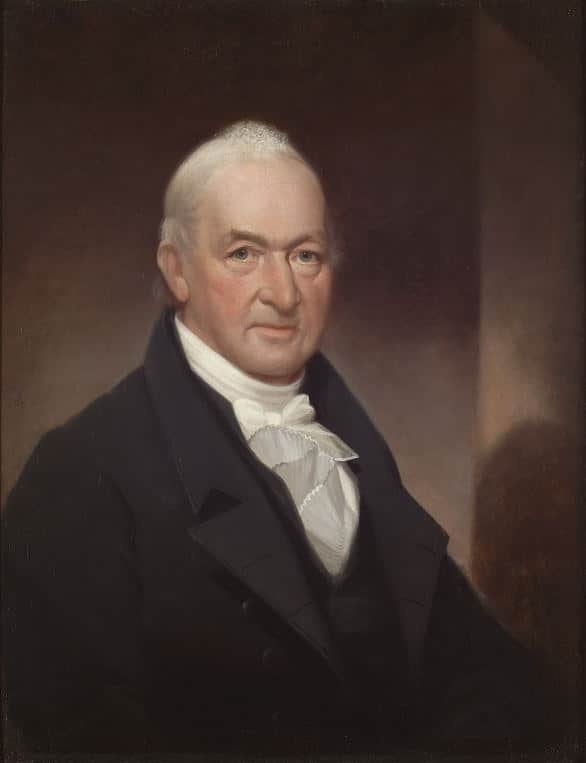Benjamin Tallmadge is best known for his service to George Washington during the Revolutionary War. He was a soldier, commander, spymaster, and politician. His work as a spymaster during the Revolutionary War led to the most successful spy ring in the history of the American Revolution.

Jump to:
Benjamin Tallmadge Facts: Early Life and Family
Tallmadge was born February 25, 1754, the son of Susannah Smith and Rev. Samuel Tallmadge, a clergyman in Setauket, New York, a hamlet in the Town of Brookhaven on Long Island. He graduated from Yale in 1773 and was a classmate of American Revolutionary War spy Nathan Hale. His relationship with Hale would have a profound effect on his life and service during the war.
On March 18, 1784, Tallmadge married Mary Floyd, daughter of Maj. Gen. William Floyd, signer of the Declaration of Independence and Governor of New York. His children included:
- William Smith Tallmadge (1785–1822), a Lt. Col. of the 46th United States Infantry in the War of 1812, died unmarried in Moscow, New York
- Henry Floyd Tallmadge (1787–1896), who married Maria Andrews Canfield (b. 1800), daughter of Andrew Adams
- Maria Jones Tallmadge (1790–1878), who married John Paine Cushman (1784–1848), was a member of the U.S. House of Representatives from New York's 10th congressional district
- Benjamin Tallmadge (1792–1831), who died unmarried near Gibraltar while a lieutenant in the United States Navy
- Frederick Augustus Tallmadge (1794–1869), who married Elizabeth H. Canfield (1793–1878), daughter of Judson Canfield
- Harriet Wadsworth Tallmadge (1797–1856), who married John Delafield (1786–1853), brother of Edward Delafield and Richard Delafield
- George Washington Tallmadge (1803–1838), who married Laura Pease (1807–1893), daughter of Calvin Pease
In 1808, after his first wife's death in 1805, Tallmadge married Maria Hallett (d. 1838), the daughter of his friend, Joseph Hallett.
Benjamin Tallmadge Facts: American Revolutionary War
Benjamin Tallmadge served as a major for the 2nd Continental Light Dragoons and was eventually promoted to lieutenant colonel. He showed excellent leadership in the field and incredible resourcefulness. However, his military exploits would not be what he became, what made him well-known.
After the defeat of the Continental Army in New York, Washington was frustrated with the lack of good intelligence. He was having a difficult time infiltrating the British and securing proper information to help his strategy. The recruitment of Nathan Hale occurred shortly after the British occupation of New York but was foiled when Robert Rogers captured the young spy, and he was hung.
The death of Tallmadge's friend, Nathan Hale, had a profound effect on the young officer. He began to plot and study a way to create a spy ring that would be successful and supply the army which much-needed information. The Culper Spy Ring was born, and Tallmadge and others recruited a motley crew of Abraham Woodhull, Caleb Brewster, Robert Townshend, and others that would play a role. The ring would be successful, and the British would never crack it.
Although disputed, the most famous action of Tallmadge's ring was learning of the betrayal of Benedict Arnold.
Benedict Arnold's British contact, John André, was caught and was taken to North Castle, where commander Colonel Jameson ordered Lieutenant Allen to take the incriminating documents found with André to their commander Benedict Arnold at West Point. Tallmadge suspected André to be a spy and Benedict Arnold to be his accomplice, and he tried to have Jameson reverse his orders.
He was unsuccessful but did convince Jameson to send a rider and take Andre to Salem, eight miles east of the Hudson River, and to send the documents to George Washington.
Allen still reported to Benedict Arnold with Jameson's note outlining the events. Later, Jameson was chastised by Washington for warning Arnold and allowing his escape. André was placed in Tallmadge's custody awaiting execution.
Tallmadge served in the Continental Army until it disbanded in 1783.
After the war, Tallmadge would help ratify the Constitution and serve in the House of Representatives and would die in 1835 in Connecticut.
